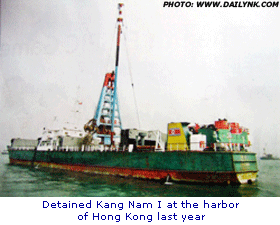
| By KYAW ZWA MOE | Thursday, May 24, 2007 |
Observers in Burma reacted with skepticism on Thursday to a statement by the country’s military government saying a North Korean ship that took shelter from a storm near Rangoon carried no suspicious cargo. They said they believed the ship was on “secret mission.”
 |
Other observers agree with his assessment of the ship’s secret purpose. A veteran local journalist said it was believed that the ship carried military equipment or an even more sensitive cargo. A normal cargo could be ruled out, he said.
Persistent reports over the past few years have suggested that Burma has been seeking to buy missile technology from North Korea. Andrew Selth, a military analyst and expert on the Burmese armed forces, wrote that in early 2002 the Burmese government reportedly began talks with North Korea on the purchase of one or two submarines.
The voyage of the North Korean ship follows last month’s resumption of diplomatic ties, which were severed in 1983 after a Rangoon attack by North Korean agents on a South Korean delegation headed by then-president Chun Doo-hwan.
The ship incident is the second of its kind within the past six months. Last November, the Korean freighter MV Bong Hoafan docked in Rangoon amid similar weather conditions. The Burmese military regime announced that it had inspected the ship and found neither suspicious cargo nor military equipment on board.
“Who knows if this latest ship brought that kind of stuff?” the Rangoon analyst asked. “No third party can inspect it.” The visits of the two North Korean ships were no coincidence, he said.
The analyst thought North Korea would probably get involved in Burma’s search for uranium to fuel a nuclear reactor. The Burmese regime has confirmed publicly that uranium deposits have been found in five areas: Magwe, Taungdwingyi, Kyaukphygon and Paongpyin in Mogok, and Kyauksin. Residents of Thabeikkyin township, 60 miles north of Mandalay, and southern Tenasserim Division, say searches are underway in those areas too.
Earlier this month, Russia’s federal atomic energy agency Rosatom announced it would help Burma build a 10-megawatt nuclear reactor for “research in nuclear physics, biotechnology, material science.” Last year, a new nuclear physics department was launched in Rangoon and Mandalay universities, and the Rangoon analyst said students had been enrolled by the government.
The analyst said he believed Burma’s military leaders might be encouraged by the North Korean example to use its nuclear program as a bargaining chip in dealing with Western governments.